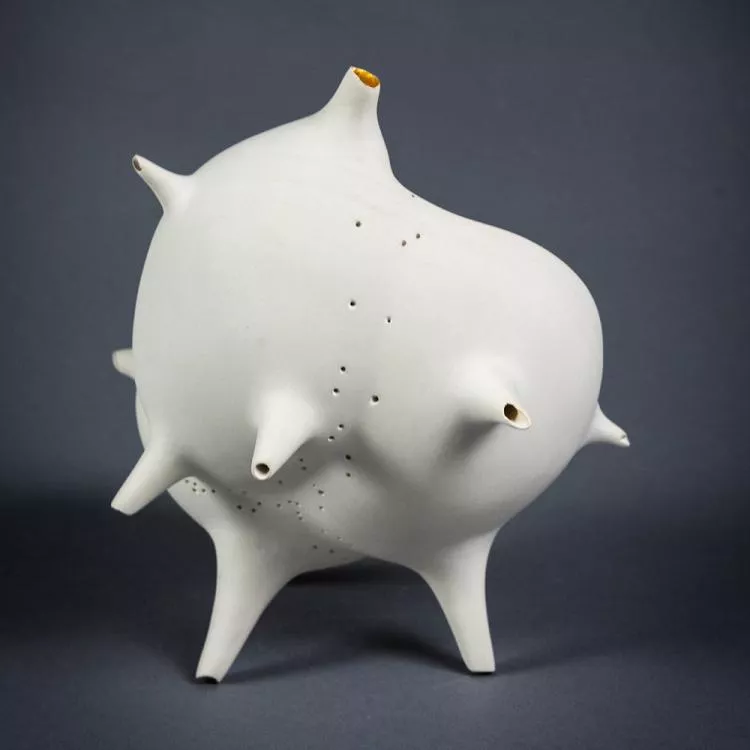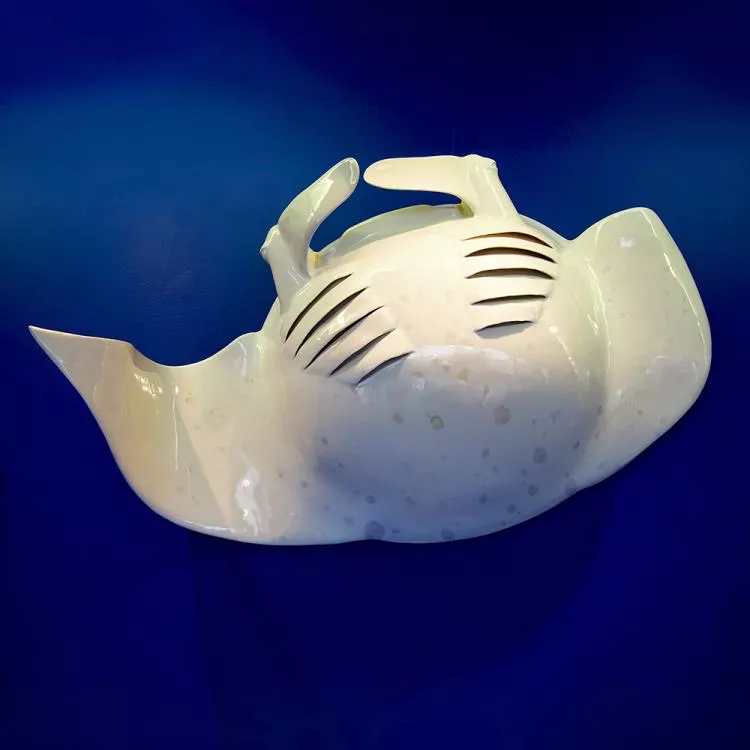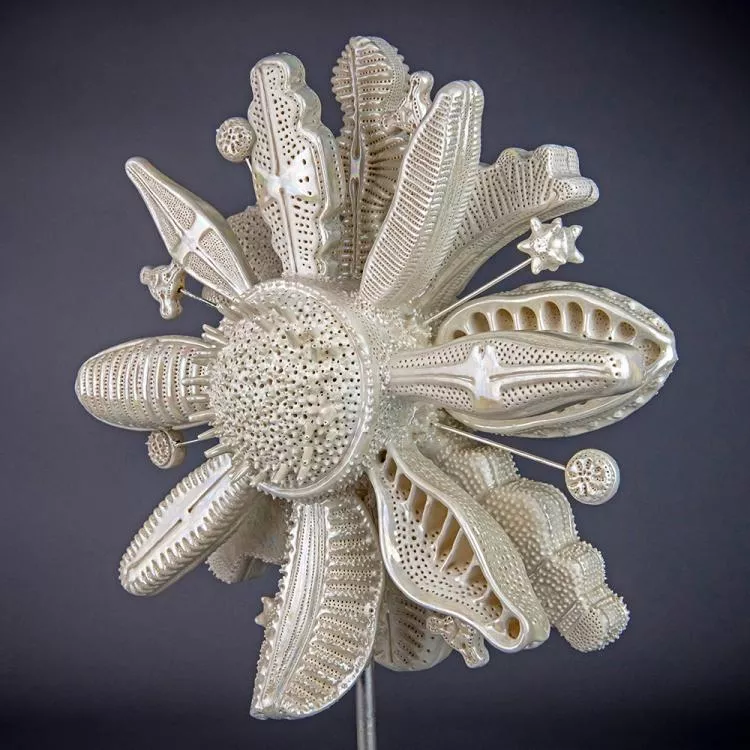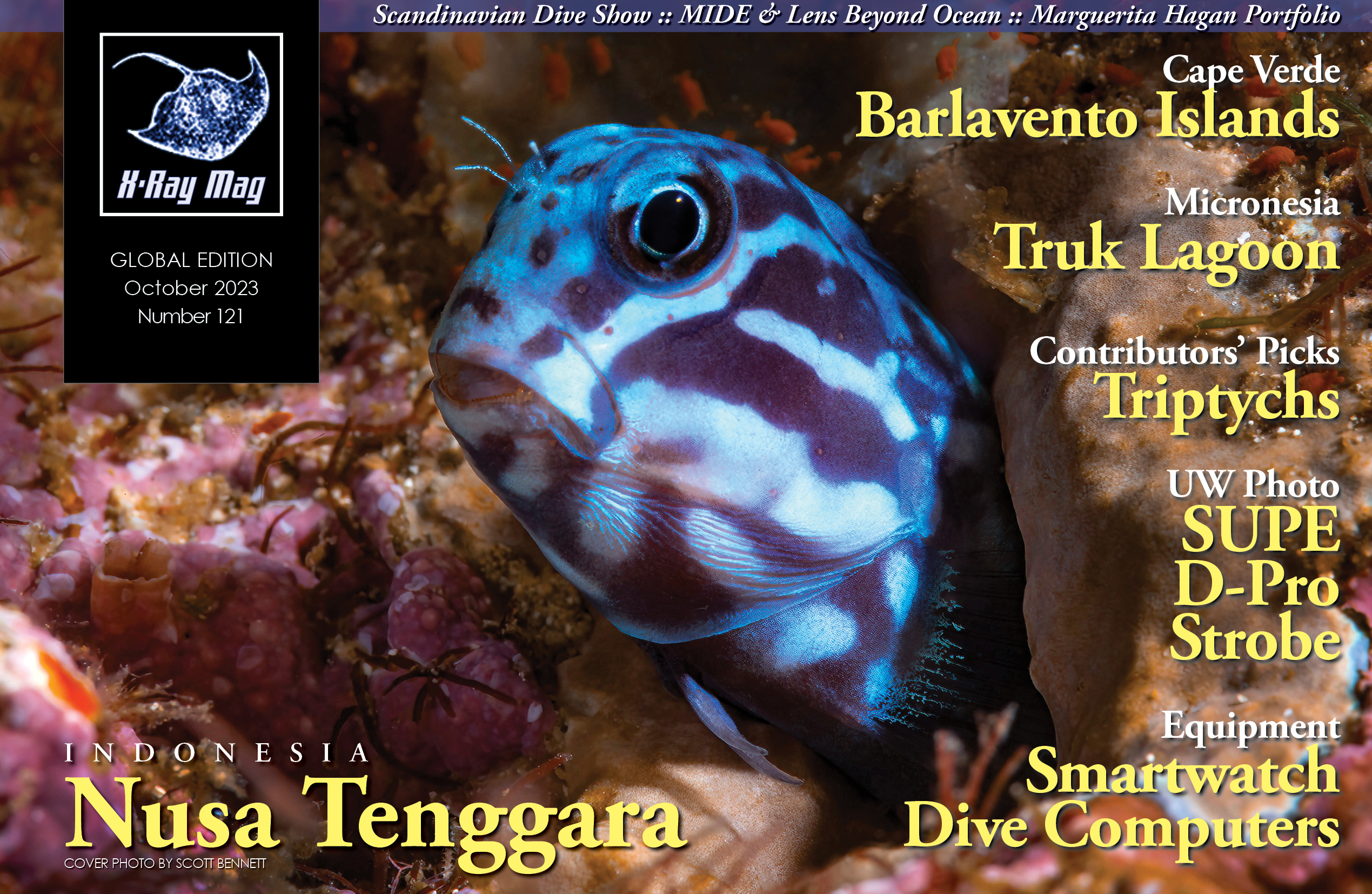American artist and diver Marguerita Hagan, who is based in Philadelphia, creates exquisite and intricate ceramic sculptures inspired by marine life and microorganisms found in our oceans. X-Ray Mag interviewed the artist to learn more about her creative process, research, and perspectives on the underwater realm and the interconnected ecosystems of our planet.
Contributed by
X-RAY MAG: Please tell us about yourself, your background and how you became an artist.
MH: I was born with a passion to learn, an insatiable curiosity, and the ninth of eleven children. When I was nine months old, my mother found me running across the mantlepiece. I was born to explore. This energy sustains, inspires and fuels me.
I was blessed with a mother who was an artist, and she infused her infectious spirit into the simplest things, as I was growing up, making the everyday a way of celebrating life. Her mother was a career artist and raised four children, single-handedly, during the Great Depression. I grew up with paintings and portraits in our home, and I visited my grandmother’s studio for drawing and painting lessons. Art was revered and a natural part of our lives.
I grew up in Norfolk, Virginia, on the Lafayette River, which fed into the Elizabeth River and the mouth of the Chesapeake Bay at the Atlantic Ocean. Going to the beach to swim in the ocean and finding treasures brought in with the tide was utter joy. As a child, I played on the beach of the tidal river, where I discovered clay. I instinctively made pinch pots and fashioned shelves on the tree branches with driftwood to keep my work safe until I could return. My first experience with clay was along the saltwater. I must have played at Little Beach from about the age of six to 10.
Nature gave us the greatest performances, as Mom would show us the beauty of a dramatic storm shifting the sky, and water moving up the river, the early morning dew drops in a flower, the sun and moon set or rise, and the stars at night. I have always been inspired by life and nature’s diverse beauty and interconnectedness.
There was not much art available in school, from kindergarten through high school, and certainly no ceramics. I knew I was not an “artist” like my sister, who painted and drew with our grandmother. I came to learn my path when clay called me back. Following alternative paths, I introduced myself to Betty Kight who became my first clay teacher, at a craft show when I was 14. I asked her to teach me, and rode my bike across Norfolk to her studio, throughout high school. I found my first love in clay.
When entering college, Ceramics was the first and only class I knew I must be in. Since I learned how to throw on the wheel in high school, it was clear to me that being a potter would not hold my interest. My teacher, Masako Miyata at James Madison University, introduced me to the low-fire clay I have worked in throughout my career. This opened the door to my visual voice. It was a defining moment, and I felt the universe light up inside me. I knew then that this was my “way”—it was like breathing for me. Clay has been my life companion, teacher and guide.

X-RAY MAG: Why marine life and underwater themes? How did you come to these themes and how did you develop your style of sculpture?
MH: Growing up in Norfolk, on the tidal river, I had salt in my veins. I have always had a profound connection to, and lived on or by, saltwater. It is where all life began on Earth, giving her the name “The Blue Planet.” Water is life and our ocean produces over 50 percent of Earth’s oxygen, providing every other breath we take. I love celebrating, honoring, respecting and protecting ALL life.
My sister, Ann Hagan Carroll, worked with Captain Jacque-Yves Cousteau during the years the Cousteau Society was based in Norfolk, where I grew up. I remember the magical trips to the Cousteau Society while visiting her, meeting “The Captain,” Jean-Michel Cousteau, and the team there, and seeing underwater equipment. My brother, Michael, was a commercial fisherman and a naturalist. Watching nature in and around the water, and the stars above, was and remains a magnificent life-long playground.
For me, working in clay is life-giving. I earned a Bachelor of Fine Arts degree in ceramics, and immediately after college, I took a cross-country trek through sacred sites and geological marvels. My destination was Seattle, Washington, in the Pacific Northwest. I lived on the islands of Whidbey and Samish, and in the Skagit Valley, just off Padilla Bay, always close to marine waters. My Wildlife series of ceramic sculptures began during this time, when I was 25 years old and had just had my first snorkeling experience in tropical waters. I was blown away by the brilliant colors and patterns of the coral reef, and the marine life living within and around it. While underwater, I saw the budding series in my mind’s eye and started it upon my return.

My work is deeply inspired by life in the sea, seeing it firsthand, and in collaborations with scientists; and although I am a research artist, once the inspiration sparks, my work is intuitive.
After being ignited by tropical wonders, I began researching and painting tropical sea life patterns on dinner plates, front and back. When I wanted to capture the pufferfish in clay, I found industrial woks in a scrapyard to use as a convex form, and the sculpture then developed into a “shield.” The first convex sculpture ballooned with dermal spines, on the wall. It begged for company, and the patterns on dinner plates expanded into my sculptural Wildlife series. But the most significant are the convex forms in saturated patterns and relief, known as my Shields. They started with the Fauna series, inspired by species in tropical and cold waters, as well as insects, birds, reptiles and creatures of the Amazon and Serengeti.
The convex ceramic forms play on the idea of a “shield,” defined as a thing of protection. A shield also honors family lineage, and in this case, the countless species with which we share this planet. Like a lens or an eye, each of my Shields beckons the viewer to take a closer look, raising wonder and awareness of our role as stewards in protecting each other and the species that make our lives possible on our blue-planet home.
The Wildlife work has evolved over the years, spawning La Mer and its myriad of series. More recently, the Flora and Fungi series have joined the Fauna series in the shield family. Respecting and honoring each other and our environment has been a life intention of mine, in which my strongest pull comes from the sea.
X-RAY MAG: What is your artistic method or creative process?
MH: No matter what I am working on, my creative process starts inside, intuitively. It may come in a moment of a dream state, or while exploring, diving, snorkeling or researching and learning about an extraordinary phenomenon in a documentary film, an article, or while visiting a scientist. For example, the snorkel dive on a tropical reef at age 25 sparked my Wildlife series, which straddles nearly four decades now. Seeing the diverse wonder of life, color, patterns and textures, designed perfectly for its environment, left an indelible impression. It all began when I swam with the tropical treasures in the sea.
Once I see and “feel” the concept, its life force bubbles up like a spring and comes through me. Whether it is an abstract work, like Nefertiti, or one requiring scientific accuracy, such as Flourish, the work feels 75 percent complete when I see it in my mind’s eye. Although there are many steps to physically realize the form, seeing it carries me through the process.
Some pieces develop with much research and connecting with marine ecologists, diatomists, other scientists and experts from whom I can learn to best craft and communicate the work’s message. My relationships with scientists and environmentalists, combined with my research, exploration and diving, buoy my current work.
With this fire lit, combined with an inner vision and insights into the life that inspires the work, be it an azure vase sea sponge or a spawning female brain coral, once I start building in clay, I listen and feel my way. Sometimes, there are surprising turns, but I trust the process.
Some of my work is intricate, and it is a blast to play outside the lines defying what appears physically possible. My earthenware sculptures are hand-built, and the process requires multiple firings, with the airbrush as an essential method in applying color as well as a clear glaze when called for. Ceramics is full of science from engineering, physics, chemistry, electrical engineering and sometimes even quantum mechanics. Hold on to your masks and regulators for a virtual deep ceramic dive!
Once the wet earthenware (ball clay and talc) clay work is sculpted to completion at the greenware (pre-kiln firing) stage and carefully dried, I may spend extensive time sanding, to smooth the surface, as in the Grow and Micro Growseries. Or it may simply be ready for the first firing, a soft bisque at cone 010 (1,640°F/894°C). This secures the work enough to handle it with care, although it is still quite delicate. At this point, I may continue sanding the surface to a glowing polish, or it may simply be ready for airbrushing with underglaze, all depending on the piece. I may need to run it through cone 010 bisque firing again, then airbrush and/or hand-paint the underglaze, sometimes through a few more stages.
The final bisque at the hottest temperature of my process is cone 04 (1,940°F/1,060°C), which stabilizes the previous steps. The temperature sets the underglaze, while burning out organic matter, for a successful smooth glaze surface. When the work is out of the 04 bisque kiln and a clear glaze (silica) is called for, I airbrush the larger surface areas, followed by a hand-painted touch-up with the clear glaze. Some works have isolated elements that need to be glazed to achieve a glossy surface while surrounded by a flat color. It requires a technician’s hand to paint clear glaze, keeping it exactly where intended.
Loading the glaze firing is a balancing act when firing fully glazed work. The glaze goes molten in the firing, so the work is carefully stilted (on ceramic bars with high-tempered steel pins) to rest on steel pins, so it floats safely above the kiln shelf to avoid the glass/glaze from fusing to anything during the glaze fire at cone 06 (1,830°F/999°C). If a luster is needed, like gold or white gold, etc, it is strategically painted over the selected glazed area for a shiny metallic pop. When isolated metallic or pearly accents are needed, it is a tight-wire act, keeping the luster only on the glazed area and to avoid staining the absorbent unglazed surrounding surfaces. The work is then fired at cone 018 (1,323°F/717°C) for the gold and other metallic lusters.
The final firing is the mother-of-pearl luster, at cone 020 (1,175°F/635°C). This is the lowest temperature of my process, to achieve the translucent iridescent magic. In some cases, like Nefertiti, Ēvolvō and Stardust, work is completed post-kiln, firing with 24K gold leaf, for example.
My sculptures, which are complex in form and research, earn a “legend” to guide the viewer through the ceramic and science details. Examples include Flourish, Interdependence and Life, Flora Shield.
As I began studying and sculpting work inspired by diatoms, I realized that the soft brick of my electric kiln was composed of diatomaceous earth. I remember as an undergraduate student, my teacher, Masako, told me that the brick was sourced from the ocean. As I know now, when diatoms die, they fall as “marine snow,” forming into a thick ooze on the ocean floor but alive with information. Micro-paleontologists decode the micro remains, which hold Earth’s history, including climate, past, present and future. Although diatoms are microscopic and just one-celled, while living, they, alone, provide over a fourth of all oxygen for our planet. They also provide my “artist breath,” making my ceramic process and kiln firings possible.

X-RAY MAG: What is your relationship to the underwater world and coral reefs? How have your underwater experiences influenced your art? In your relationship with reefs and the sea, where have you had your favorite experiences?
MH: My maiden snorkel in the tropical waters of Hawaii, in 1984, inspired my entire Wildlife series and 40 years of work. My first dive in Martinique, in 1990, inspired my Tropical Tea Party, and so much more. Later dives, in 2019, inspired my La Mer coral and sponge series, Marine Abstracts. I returned and worked from May 2019 and onwards, for a year, on the coral and sponges, leading to the time of lockdown, when the pandemic reached the United States. I had never had an obsession with sponges before, but they pulled me in, with a marine tractor beam, on that Cayman trip.
By December 2020, the first Covid vaccine was developed, and I learned that it was modeled after the compounds in a sea sponge. I now understood why the sponges were getting my attention. As the ocean’s filter system, they clear bacteria, viruses, etc. This led me to learn that they were also the source of the first AIDS and cancer treatment. Again, our lives depend, in countless ways, on protecting our ocean and environment.

I had a few moments gifted to me in the Caymans. One was seeing my first spotted drum, a shy creature, at 100ft down on Cayman’s North Wall. It had inspired one of my first designs, painted on dinner plates and large shields. So, I was over the moon, after 39 years of putting its pattern on my work, to finally catch the beauty in person, before it hid under a rock. I was also tickled to see a pufferfish on this dive and—be still, my heart—an eagle ray, sailing by me from the wall to the infinite expanse.
Each dive is a gift, and yet, I feel my most dramatic experience is in my future, when I hope to dive with manta rays, whales and cuttlefish. Finding ways to continue diving and do at-sea residencies is invaluable, as each opportunity yields immeasurable rewards.
X-RAY MAG: What are your thoughts on ocean conservation and coral reef management and how does your artwork relate to these issues?
MH: Ocean management and restoration are essential. My sculpture magnifies life in the ocean from micro to macro, through exhibitions, lectures and projects. My practice gives visual voice to the ocean depths, uplifting awareness, education and stewardship of this fragile life support that is our planet, upon which our lives depend.
Not everyone can dive. It is a privilege and a gift to be able to do it. So, sharing the magical undersea realm is not just an honor, it is a responsibility. As Jacques Cousteau once said, “People protect what they love.” My work is a request to fall in love, now.
Once you get a glimpse of and learn about the unseen world in the oceans, and its life-giving jewels, there is a universal response of “Love.” You cannot help but love these gifts. Combined with commitment, love motivates sustainable action, leading us to transform systems. We are intrinsically linked to the ocean, and it is in immediate need of our protection. Illuminating marine life invests in the mutual wellbeing of humanity and the planet.
One highlight in my environmental work experience was being part of a project at the American Geophysical Union (AGU) in Washington, D.C., in December 2018, when the AGU held its annual gathering of 26,000 earth and space scientists from around the world. I was honored to be one of two artists, along with two of the top coral scientists, and an American scientist’s important work in Singapore, featured at AGU’s fall meeting. We presented, “The Coral Reef Ecosystem: Observation, Configuration, Communication at the Intersection of Art and Science.”
At the core of the poster session was the concept that art and science are interconnected, each with the power to inform people about our natural world and climate change, in particular. Thus, along with presentations of the 100 Island Challenge project of Sandin Labs at the Scripps Institution of Oceanography by Dr Stuart Sandin, the NOAA Coral Reef Watch program, under Dr Mark Eakin; and Dr Nathalie Goodkin’s work from Earth Observatory in Singapore, there were two artist presentations.
I exhibited a selection of my La Mer sculptures and shared inspiration from my marine research. Artist Diane Burko, who coordinated the event, shared her book, Endangered: From Glaciers to Reefs, which highlights her exhibition at the time at the National Academy of Sciences. The poster session served as an introduction to the associated panel, presented in a town hall meeting, including Sandin, Eakin, Goodkin, Burko and myself. Eakin was also the science specialist on the Netflix film, Chasing Coral (a must-see, along with the documentary, Mission Blue, with “Her Deepness,” Dr Sylvia Earle, on Netflix.)
I have presented many times over the years, each one expanding the message to hearts and minds. The collaboration of art and science at the AGU event, honoring our coral reef ecosystems, was a high-water mark. I look forward to ongoing opportunities to share my work and its message publicly with collaborators in art and science.
X-RAY MAG: Several of your artworks embody complex science and marine biology. Please describe how you bring together art and science in your creative process.
MH: It all started with my Wildlife work, 39 years ago. The launch of my La Mer series, eight years ago, accelerated this focus—the brilliant colors and patterns of tropical coral reef life to the abyss—and has evolved exponentially over the years. While preparing for a solo show at Esther Klein Gallery, part of the University Science Center in Philadelphia, a new series was conceived. The curator, Angela McQuillan, offered me a solo show of my Wildlife Shields.
In preparation for an exhibit, I gather my species list—typically, a diverse list representing ecosystems around the globe. This time, however, 90 percent of the species I listed were from the ocean. I paused. I then revisited 19th-century artist and scientist Ernst Haeckel’s drawings in Art Forms in Nature, originally published in 1899. I saw a page of exquisite spiky forms, which grabbed me by the shoulders. I was in love. These drawings were shields just waiting to be made! What they were, specifically, I was to discover, but the marine forms had me. I sensed I was going in deep and embarking on what would be a life-changing adventure.
A new series was born devoted to the ocean from micro primary producers to our largest living creature, the blue whale. La Mer set sail with the exhibit Scintillare at Esther Klein Gallery, during the first week of December 2015. That same week, world leaders gathered at the UN Climate Change Conference (COP21) in Paris. During my exhibition opening, they announced that they had extended the conference, and eventually reached a breakthrough on December 12th, 2015, known as the Paris Agreement. The only person in the talks not representing a country was Dr Sylvia Earle; she was representing the ocean.
My environmental focus was not new, but it was time for a powerful human alert and response for a complete about-face towards positive change. La Mer was my answer to this call.
Through the exhibits, installations, residencies, collaborations and lectures with La Mer, I have connected to scientists, science museums, art and science residencies, lectures and projects. It has given me a voice and given voice to our planet’s largest element, the ocean. I feel I have only just begun. There is much ahead, and it is evolving with every new work, connection and sharing.
X-RAY MAG: On your website, you mention the interconnected relationship of all life on our planet and the fragile nature of our marine ecosystems. How does your artwork address these themes and what is the most important experience or message you want viewers of your artworks to have or understand?
MH: The comprehensive installation, Interdependence, embodies this spirit in fluid animation video projection, as well as its title, and the 139 La Mer ceramic sculptures swimming across the 33 x 15ft wall. The ceramic sculptures magnify the forms of microscopic organisms, anemones, squids, cuttlefish, manta rays and whales.
The installation was inspired by the 50th anniversary of Earth Day, on April 22, 2020, which the Michener Art Museum celebrated in the exhibit, Rising Tides: Contemporary Art and the Ecology of Water, curated by Laura Turner Igoe. I chose to lead with the first image of our blue planet fully illuminated by the sun, which was taken by the astronauts of Apollo 17 when they broke protocol from their strict schedule. The most recognized photograph on Earth, The Blue Marble, became the iconic symbol of Earth Day.

See videos and legend about the sculptures and species in the installation, Interdependence, by Marguerita Hagan.
In the installation, the La Mer sculptures flow with the ocean currents around Antarctica and Africa, and the surrounding oceans. When viewers approach the wall, their shadows are intentionally imposed on the installation. We leave a mark wherever we are, and seeing one’s life-size impression on our planet and oceans makes a bold statement. The only impact we have time for now, or ever, is a positive one. The inclusive title of the installation, Interdependence, illuminates the message in my work.
The video projection with audio, mapped onto the La Mer sculptures, creates an immersive experience, presenting the big picture, with highlights on the jewels of our oceans and our responsibility as stewards. Interdependence is a collaboration with cinematographer and friend Richard W. Gretzinger who mastered the video and animation. There are four two-minute segments in the looping eight-minute animated video (Earth, Dive, Plankton and Stillness).
Engaging viewers to step into this inclusive perspective raises wonder, awareness and action for a complete change in the way we see and live, during this increasingly critical time on Earth.
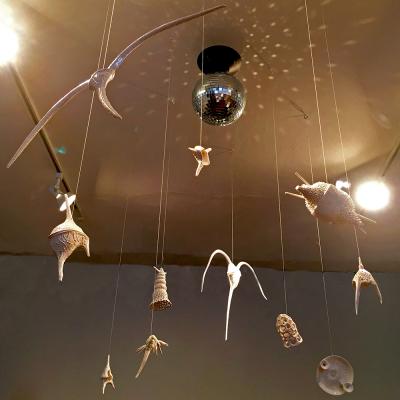
The video starts with Earth as seen by the astronauts on the 1972 mission. This is our home, and we are part of a vast and interconnected universe. We hear the sound of space (NASA sonifications) with a subtle heartbeat. Dr Sylvia Earle calls the ocean the blue heart of our planet and we must take care of her heart. As the video zooms into the sea, one can hear mother and calf humpback whales begin to sing to each other.
The one-celled marine organisms in the sunlit layer of the ocean produce our every other breath. Their engineering expands with the exquisite colonies that serve the greater good. It is time we got the memo. They are microscopic, but they power our planet at the macro level, which can be seen in satellite video from space of plankton blooms in spring. Interdependence brings this to light with the sequence of swirling green, dancing across the installation.
Water is life, and protecting the environment is essential for our own survival. Mother Nature will thrive without us, but our lives depend on her.
X-RAY MAG: What are the challenges or benefits of being an artist in the world today? Any thoughts or advice for aspiring artists in ocean arts?
MH: Artists historically have been among the pioneers of new ideas and directions. Typically living “outside the lines” of the mainstream offers an expansive perspective for those lucky to see and feel it. Look to art across the timeline to get the pulse of consciousness at any given era. This role is an investment and responsibility, especially at this intense time on our planet. Everyone makes a difference, and working together is how we can transform systems into inclusive support. Dive in and keep following your vision. Connect with those of like mind and spirit to build community. “No one is an island,” indeed. Look at coral reef communities for an inspiring model.
Jacques Cousteau said we need to play more. He once described that he and Émile Gagnan were “playing” in 1943, when they invented a self-contained system that made it possible to breathe for long periods of time underwater. Curiosity and imagination gave us scuba, and a self-contained underwater breathing apparatus was born 80 years ago.
Just 67 years ago, an underwater camera was designed for Cousteau by Belgian engineer, Jean de Wouters. It was the year 1956, and the camera was called the Calypso-phot. Look at how rapidly technology has raised our perspective and visual communications, and where we are today. As challenging as it is on our planet, there are equally extraordinary developments, discoveries and inventions every moment. We must keep our sights high above the horizon and trust in the infinite resourcefulness within and around us.
We are in this together, and the only way forward is inclusively. It can be overwhelming at times, but we must remember that in this spirit, every positive intention makes a difference, and with focus, manifests into action. Each step no matter how small creates a positive shift moving us forward collectively.
You are not alone. We are united through the most beneficial outcome possible. Consider the diatoms that have been contributing to our atmosphere for over 200 million years, one microscopic cell at a time. As the human family and ambassadors of our beautiful blue planet, turning this ship around requires shifting our perspective. It is an ongoing process and continual adaptation, learning and creating sustainably. Everyone’s voice and gifts play a unique role and contribution.
X-RAY MAG: Your projects with students and young people are inspiring. Please share with us your approach to art in education as well a memorable moment with the students.
MH: Everyone has a dream and path of their own. As a teacher, it is a joy to support individuals in cultivating their own voices and visions. Over my career, I have worked with children from age three to 103 years old. Intergenerational projects hold a special place in my heart. I have had the privilege of working with bright and brave souls on inspiring projects.
There are two examples on my Projects webpage and more to be included. Let me share the permanent installation at Westtown Friends School entitled, Primary Producers: Primary Artists. I was invited by teaching artist, Jeff Waring, to guide his pre-kindergarten, kindergarten and first-grade artists on an expedition. Being “primary students,” the jewel-like marine “primary producers” felt like a perfect focus.
We studied the microorganisms of the sunlit layer, their essential role, and our need to care for them and the ocean. Children are natural artists, and this was a brilliant experience, watching them soar with their drawings, works in clay, and paintings. You can see the gorgeous results, and it was so fun that the installation was placed by the entrance to the playground.
X-RAY MAG: Lastly, is there anything else you would like to tell our readers about yourself and your artwork?
MH: As an activist for thriving, mutually sustainable communities and environments, “interdependence” is the focus of my practice, in my sculpture, teaching and community arts. I am inspired by life’s interconnected and diverse wonders, both within and around us.
Nature has been modeling this forever, be it microorganisms forming exquisite colonies to pro-duce more oxygen collectively, oak tree roots grafting for miles in inter-connected systems, or the “wood wide web” of mycorrhizal fungi mutualism. It is this light force that has enabled all life to thrive for eons that fuels my practice. We must work together to move forward in all ways socially and environmentally, as if our lives depend on it, because they do.
Supporting each other, especially our younger generations is a part of this inclusive perspective. Seeing and realizing possibility in ourselves, each other, and everything around us is powerful and a lot more fun. We have to have fun and be kind.
This message is beyond critical now, as we have tipped our planetary scales. Broadcasting these little-known, mighty, marine beauties serves as a climacteric wake-up call. The time is now for humans to take responsibility for our dire damages and dive into imperative restoration.
If one-celled organisms can support the entire planet for millions of years, imagine what we can do when engaged together. ■
See videos in the installation, Interdependence, at: margueritahagan.com/installations
More information and views of the sculptures can be seen at: margueritahagan.com. Follow the artist on Instagram @marguerita.
See the artist’s current exhibits. Click on the links below for more information:
In The Umbra, at Chimaera Gallery until 28 Oct. 2023
Magnificare, at the HUB-Robeson Galleries until 22 Feb. 2024
No Synthetic Colors, at the Pennsylvania Academy of Fine Arts until 7 Apr. 2024












